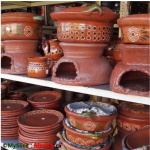
This is a quick recap on one of my favourite crops (gardening zone 6B), the sometimes under-appreciated parsnip (Pastinaca sativa). As I wrote in early spring, I restrained my impatient self from harvesting all my sweet parsnip roots, and left one in the ground, hoping that it would bolt and grow some seed. Parsnips are part of the Apiaceae family, which includes other vegetables (such as carrots and celery), herbs (such as parsley) and also many ornamentals, appreciated for their characteristic clustered flowers, forming an umbel (the family is also known as Umbelliferae). At the beginning of June, I reported a huge growth spurt on my plant, and indeed some blooming was spotted, which has developed over the past two months, as may be appreciated in these photos:
Each of the flat ovals is a fruit, which are now mostly dry and ready for the harvest (see photo at the top of the post, taken this morning.) What a resplendent way for this parsnip plant to complete its life cycle, gifting hundreds of neat pockets, each carrying seed for my next crop! Sowing time is usually in the spring, to allow the tap roots enough time to develop, then left to overwinter for sweeter roots the following spring; I will save lots of seed in a paper envelope until then, but I am doing a little experiment by spreading a few ovals now; maybe some will get swollen and sprout before winter comes:

And although I could pull the aging parsnip plant now, I will leave it alone until it dies of natural causes in the fall (parsnips are biennials), since I have no more planting for that spot this season, and also because the neighbouring tomato plant decided to grow on a spiral around the tall parsnip stem (below). Oh, what a noble life, even serving as a trellis now!

FUN FACT – According to Wikipedia: “Like carrots, parsnips are native to Eurasia and have been eaten there since ancient times … The parsnip was much esteemed [by the Romans], and the Emperor Tiberius accepted part of the tribute payable to Rome by Germany in the form of parsnips.”










I love parsnips! I haven’t had much luck in the garden with them, although I got two overwintered ones this spring. I may give them another try next year. Fun to see the cycle in your photos.
LikeLiked by 1 person
Do you have trouble with germination? It is very low, about 60% in general, so it is better to over-seed; also, it could take up to 21 days! So it is important to keep the site constantly moist. I have found that pre-soaking the ovals helps a lot; I have a sprouter, so last time I placed some ovals there until they developed a bump (the beginning of germination) and then sowed them.
LikeLike
I wish the dill was biennial! At least some of it is also supporting tomato branches. I haven’t tried parsnips and my carrot efforts have been poor. Part of my problem is not getting around to thinning when I should. Sucks to be lazy!
LikeLiked by 1 person
I got exactly zero carrots this year; I failed to keep them moist because I was in Iceland for a few days. Ah, and I corrected “Umbillifers are bi-annual” and wrote “parsnips are biennial”; thank you for mentioning dill and using the correct word “biennial” (every two years) as opposed to “bi-annual” (twice a year) Yikes!
LikeLiked by 1 person
Great details in your photos and the post too, of course. I particularly like roast parsnips!
LikeLiked by 1 person
Thank you! Roast parsnips are my favourite, too!
LikeLiked by 1 person
Fun experiment! You will probably find you get better germination from your fresh seed than bought seed – parsnip loses it’s viability rapidly. It also will tend to lose it’s vigour as a plant unless you let several plants flower at once and cross (like corn), not a problem for one season in my experience though.
LikeLiked by 1 person
Thank you for the tip, I will make sure to let at least two plants grow next year!
LikeLiked by 1 person
wow, the parsnips changed a lot in one month. What do you do with them? do you cook with them?
LikeLike
The flat ovals are basically seed pockets for my next crop; I harvested the edible roots back in March (see https://mysliceofmexico.ca/2018/03/18/backyard-stories-parsnips-are-zen/) when I decided to leave one in the ground to see if I could get seed. The roots were amazing roasted with a little olive oil and salt, but you can mash them, and I have heard that you may eat them raw.
LikeLiked by 1 person
oh yeah, I remember that one now.
LikeLiked by 1 person
I have been meaning to cook Parsnip but too much procrastination!
LikeLike
I have never tried parsnips from the store, and I have been told that once you’ve tried homegrown, you don’t want to go back. Maybe I will buy some one of these days, just to compare. So far for me, the yummiest way to eat them is roasted with a drizzle of olive oil and a sprinkle of salt.
LikeLike